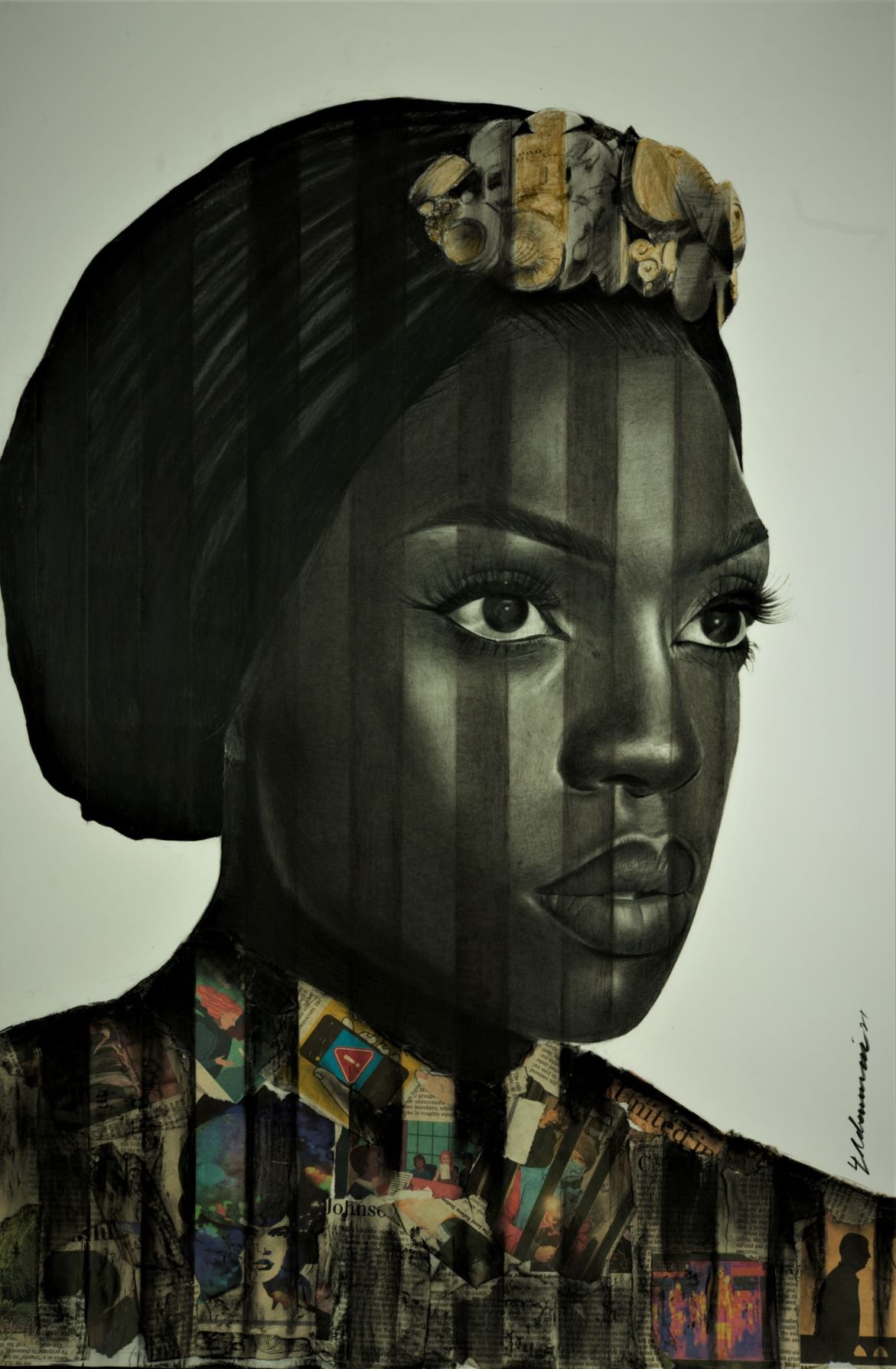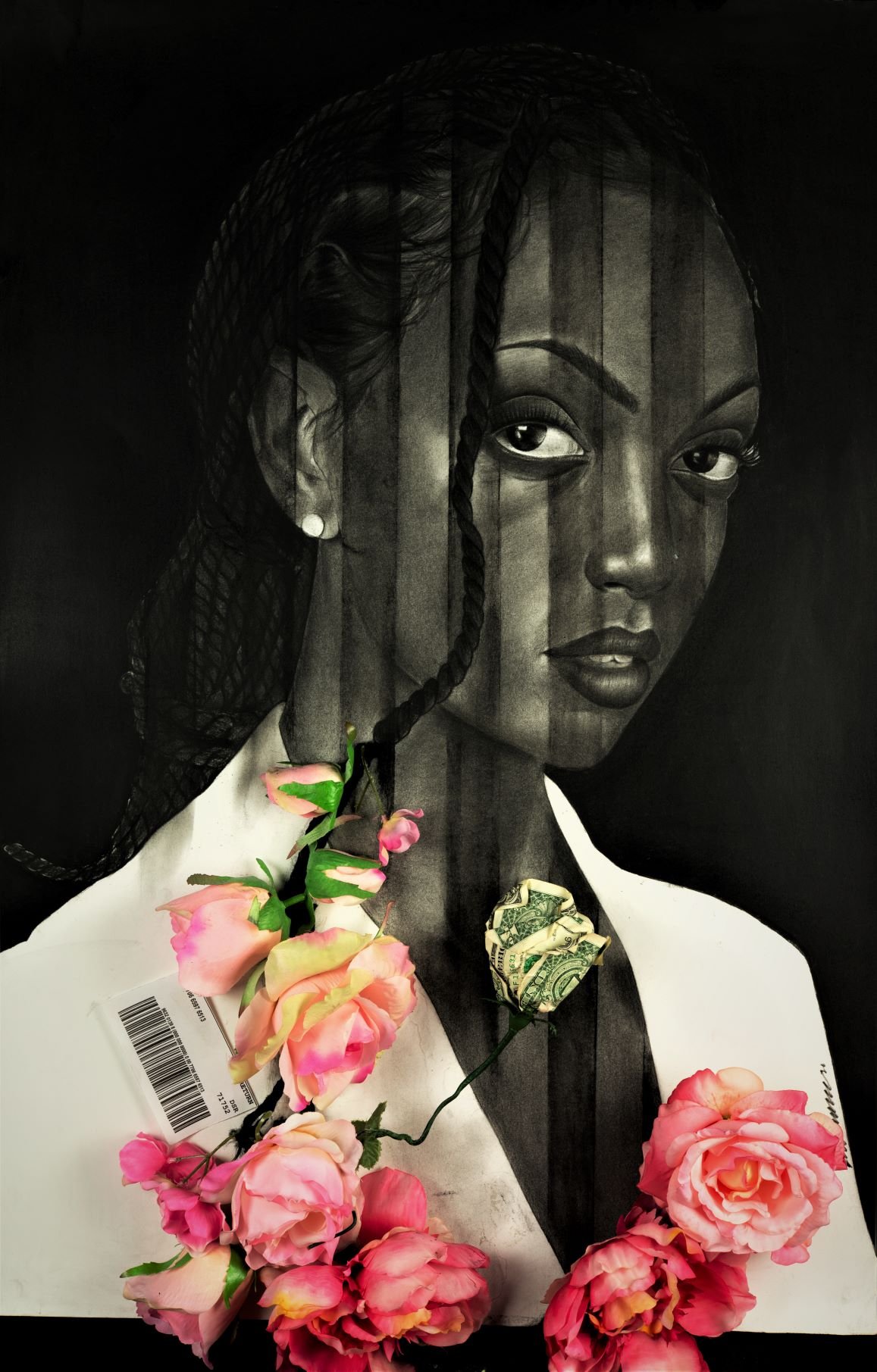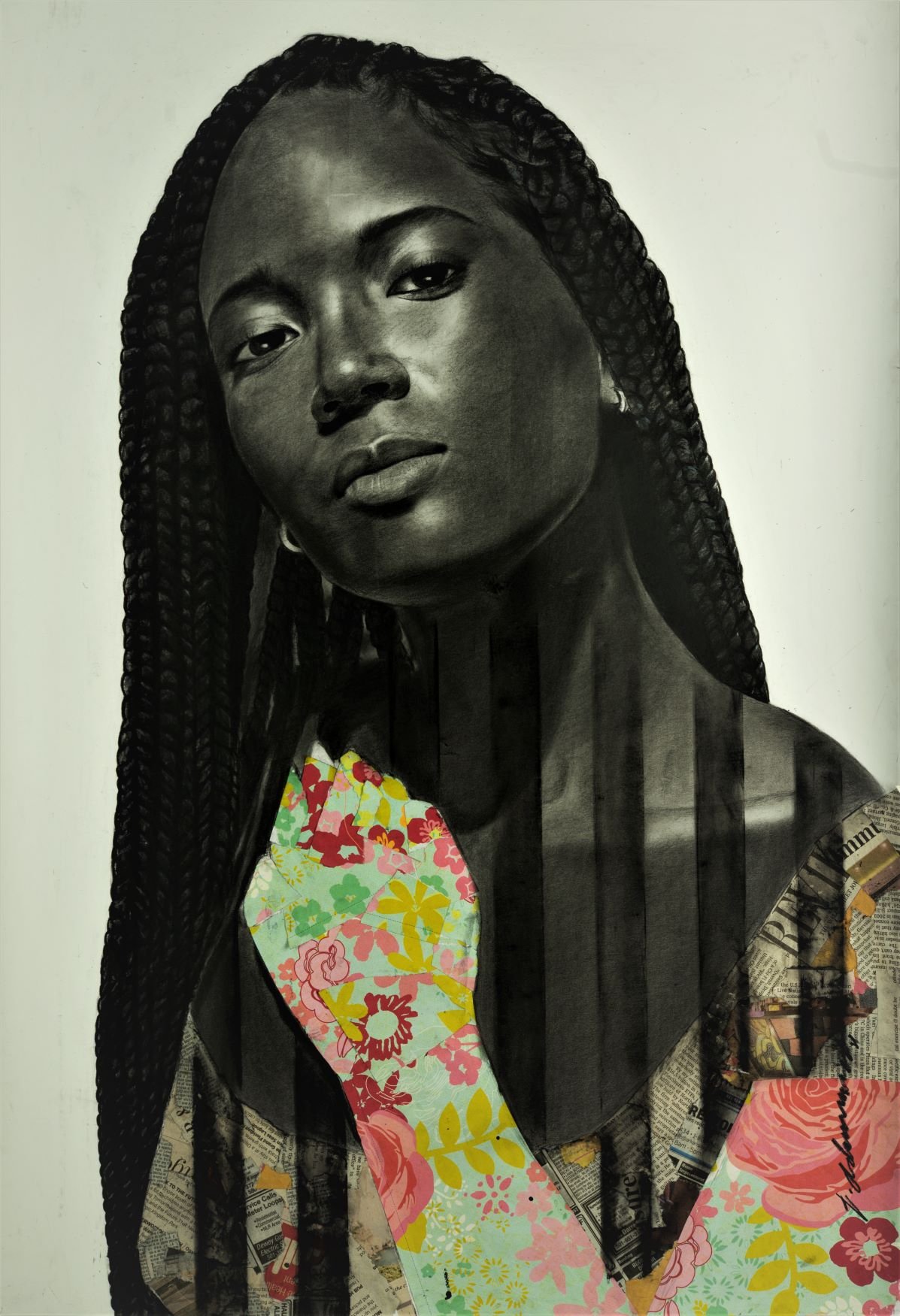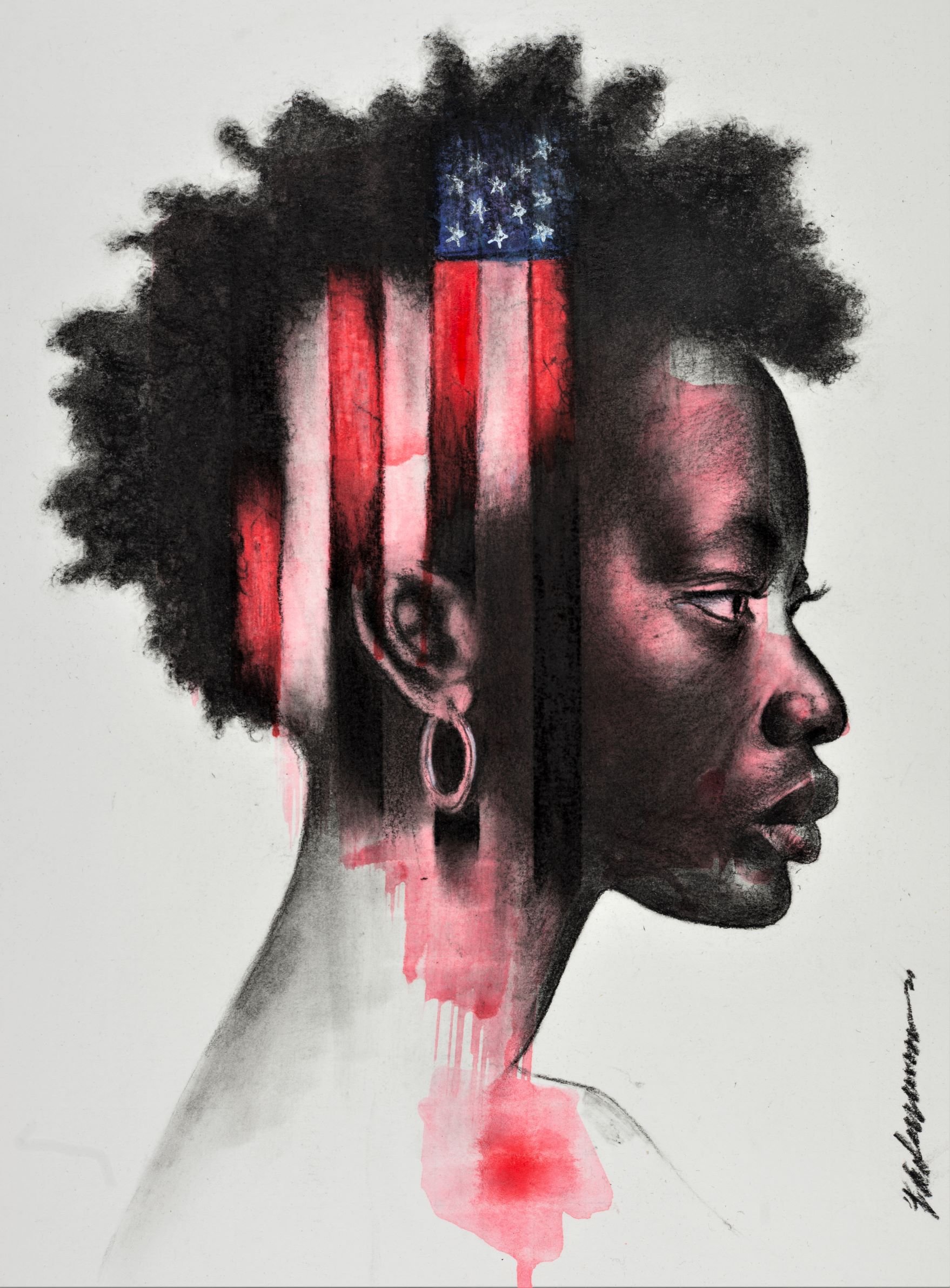Interview with artist Oluwatobi Adewumi
Oluwatobi (Tobi) Adewumi immigrated to the US from Nigeria in 2016 to study art. In 2017 he settled in McNeil, Arkansas and is a full-time artist. Tobi’s rich charcoal drawings are portraits that tell a complex story confronting stereotypes and myths. More of his work can be found at Art Ventures in Fayetteville, Galleries at Library Square in Little Rock, Boswell Mourot Fine Art in Little Rock, and at his website tobiadewumi.com. (profile photo by Jenn Terrell Photography)




AAS: Tobi, talk about your background and what brought you to the US and to Arkansas.
OA: I was born in Oyo State, Nigeria. My interest in art started in the 1990’s when I won an art contest – the overall award in Nigeria – and I’ve kept studying since, although I am mostly self-taught. I studied computer science at Olabisi Onabanjo University, Ogun State Nigeria and earned a B.Sc. degree in 2010. But I have never actually worked in my degree field. I did my art residency at Arts Letters and Numbers near Albany, New York in 2016. I then relocated to Arkansas from New York after getting married to my wife in 2017. After I arrived, I met the Associate Dean for Multiculturalism and Diversity at Southern Arkansas University, Cledis Stuart. He liked my art and introduced me to the chair of the Department of Art and Design, Steven Ochs, who later offered me a solo art exhibition at SAU.
AAS: Did you have artist role models growing up?
OA: No not really in my family. My elder brother used to draw when we were younger, but he stopped when he got older. But I did have lots of role models as a self-taught artist in Nigeria like Bruce Onobrakpeya, Abayomi Barber, Yusuf Grillo, Ben Enwonwu, Abiodun Olaku, and many more, and American artists like Kerry James Marshall.
AAS: You’ve said your work explores your personal journey from Nigeria to McNeil. Why has that been so important to you – to document your personal journey with your art?
OA: With every piece of art I produce comes a story, an opportunity to provide history, a new voice, narrative, and perspective for my audience. I believe in using my artistic gift as a conduit to share the stories of people and places living in a different society and culture but with a new context.
History is a big part of my art practice. My life in Nigeria, then relocating to McNeil, are all helping me with my perception of me being Black and the connection with the world around me as an immigrant. My art takes on reconstructing lost stories, documenting the ideals of our history. I want to challenge stereotypes and myths that have been crafted by others.
AAS: There are some very powerful images in your Scarface series. Would you comment on that series?
Scarface I, 28” x 22”, charcoal on paper
OA: That series tells the story of our future as Africans by going back to the past to explore the old traditions, cultural values, and style. The focus is primarily on tribal/lineage marks, style, scarification/face painting, and genealogy. I want a conversation with the new generation, so I created a story that shows some of the cultural practices such as tribal marks, face painting, style, fashion, hairstyle, and some conceptual faces. I think the new generation should question how their past might influence the future generation. For Example, Scarface l shows the man with marks on his face: Tribal marks can be traced to 14th century West Africa, especially Nigeria. They are marks engraved by piercing the skin, and serve different purposes such as beauty, spiritual protection, and native medicinal purposes. They were also very popular during the Nigerian Civil War [1967-1970]. Different groups used them to differentiate one tribe from the other and even serve as a means of identification – different tribes have their unique tribal marks which signify different things. The powerful historical meanings behind scarification is getting lost.


AAS: In your most recent works you feature beautiful Black women, Americanized and proud but guarded and vigilant about not losing their identity. At least that is what I see when I look at Whose Story.
Whose Story, 36” x 26”, charcoal and collage on paper
OA: Every portrait I do I make sure I know the person and at least a little bit of their story. These women are my muses. Whose Story is a work looking directly at the viewer and asking questions: Whose story should we read? Do you really want to know? Do you care? Do you know what happened at work? Do you know how many times I’ve been abused? I wanted to show her beauty and power. Despite the challenges she faces, she will not lose her real identity.
AAS: You describe your drawings as layered portraits that combine elements of realism and abstraction. I think Headlines is a good example of that. Talk about that piece and why you use that approach for your portraits.
Headlines, 36” x 26”, charcoal and collage on paper
OA: I choose my subject for the portraits according to the topics or issues I want to talk about and those that connect me to my roots. The figure or portrait is always direct to give viewers a connection. The newspaper collages add to the piece by giving the viewer a glimpse of how powerful our thoughts can be. The newspapers also connect current issues that can hold a person back or push them forward. The images say a lot if you pay close attention.
In Headlines, I specifically chose the text and pictures to make the viewer pay attention to real feelings and issues that are a part of the woman’s life. For example: the newspaper figure in the hoodie, represents how black people are considered suspicious when seen in a hoodie. In spite of what people see, she is still this strong woman making the headlines. Other examples include text such as Power, Faster, and Stronger that help her stand a little taller. The portrait has lines on her face that represent labels that society places on her and the newspaper collage that forms her body is used to show how society perceives her: sexism, inequality etc. The face shows that Black women are varied, resilient, powerful human beings. Headlines peels away the layers of labels cast upon Black women by the larger society, to reveal their truth.
AAS: The effects you achieve with charcoal are amazing. What is it about charcoal that makes it your medium of choice?
OA: Thanks. I love drawing and charcoal is one of the media I started working with 12 years ago because it gives me more texture, depth, and more tonal values. It’s very versatile. Color can distract you sometimes.
AAS: In Caution, you really lay it out there and the way you use charcoal adds to its impact. Her eyes tell a profound story of hurt and distrust.
Caution, 36” x 26”, charcoal, acrylic and collage on paper
OA: Caution is a piece that shows a beautiful black woman who is a strong advocate for diversity and inclusion in the society. I used red acrylic paint in the background to relay the message that she is a force to be reckoned with because she believes that all people who are not given a voice should have one. Though her features and messages are strong, there is still beauty in the piece. Both can coexist.
AAS: Another powerful social commentary is Everything You Need. What is the story behind that work?
Everything You Need, 36” x 26”, charcoal and collage on paper
OA: My muse for this work is a friend I met a couple of years ago. I loved her look and when I was preparing to paint her, I asked her a little bit about her life story. It was inspiring to know more about her personal challenges. Everything You Need is basically a definition of a black woman: strong, talented, loving, selfless, etc. She was in a physically and emotionally abusive relationship for 7 years and she told me that walking away was “my biggest empowerment.” We are both happy with the way the portrait turned out. And it got a lot of positive reaction and attention at Basel Miami.
AAS: Oh, so you were recently at Art Basel in Miami? What was that experience like?
OA: Yes, it was a great experience, made possible by Kyle Boswell of Boswell Mourot Fine Art in Little Rock and Grace Arts Florida. They helped showcase my art to thousands of people. It was a blessing and I love the feedback I got from the visitors.
AAS: Your work as a computer scientist is very analytical, precise, and structured. Your art also has some of those characteristics. Do you think you use an analytical approach to creating your art intentionally or subconsciously?
OA: I would say that it is both. I didn’t realize it until you asked me this question. I do take an analytical and structural approach in most of my pieces. I choose a muse or model that will work with the topic I want to talk about. I always like to use realism and a portrait style to draw my viewers in. I also use my collages to drop in more details. But I feel that adding the newspaper collages has allowed me to break away from the analytical approach a little and be more creatively spontaneous.
AAS: Tobi, I have to ask, what is it like being an artist in rural Arkansas?
OA: That’s a good one. Working here is slow and quiet and that I like. However, it has forced me to be creative in showcasing my work to bigger audiences. Yes, sometimes I feel I should be living in New York, LA, or Chicago where there are several big art events, exhibitions, residencies, and grants available. I am very thankful to the many people I’ve met since moving here that believe in my art practice. Some of those people include, Sharon Killian of Art Ventures, Kyle Boswell of Boswell Mourot Fine Art, Steven Ochs of Southern Arkansas University, Brad Cushman of UALR, Debra Woods of the Galleries at Library Square, and Will Hogg of ACANSA Gallery. Thanks to you all!





